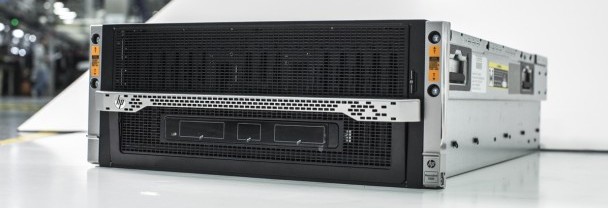Last Monday, HP released the new HP Moonshot platform, a new set of server products specifically built to take less space, less power and less operational cost than traditional servers in the datacenter. In Moonshot, HP is attempting to solve the issues data centers face today with finding ample power, finding space and cooling challenges.
HP Moonshot is moniker used for both the chassis and the server cards inside of the chassis. It is a similar concept to the blade servers HP and other vendors have produced, replacing the blade with a server card similar to what you’d see in a switch chassis.
 The chassis itself is an oddly sized, 4.3U server enclosure and serves as the basis for the ecosystem with 45 slots for server cards and two network switches with shared power and cooling. The card based servers are a rethink of what defines a server – a small footprint system-on-a-card based around low power processors. As for space consolidation, HP says that what previously would have occupied 10 racks of 1U servers can be accommodated in a single rack with 10 Moonshot chassis.
The chassis itself is an oddly sized, 4.3U server enclosure and serves as the basis for the ecosystem with 45 slots for server cards and two network switches with shared power and cooling. The card based servers are a rethink of what defines a server – a small footprint system-on-a-card based around low power processors. As for space consolidation, HP says that what previously would have occupied 10 racks of 1U servers can be accommodated in a single rack with 10 Moonshot chassis.
The first set of Proliant Moonshot Servers are based around Intel Atom processors. Being x86-based, much of the world’s current server software should work with these new servers, something that will be key to adoption of the new form factor in the datacenter. In addition to these Intel Atom processors, HP also announced plans for tailored servers for specific business needs. These servers may be stocked with specific hardware for a task and future server will include ARM processors, too. The ARM based servers will likely require a lot of rewrites of applications for compatibility, but given the amount of experienced ARM developers for mobile, its not a stretch to consider server code being written on ARM.
Oddly (to me at least), HP has a requirement that all 45 server cards be identical in an enclosure according to the QuickSpecs found online for factor integrated models (thanks to Chris Wahl for that information). At launch, there is only a single Proliant Moonshot server card available. The requirement to buy a fully populated system is a clear sign that HP is targeting the Moonshot systems towards service providers and serious datacenters running lots of web applications on traditional server hardware. It is concerning for enterprise who tend to mix and match server models in blade enclosures to fit specific needs. Moonshot’s uniform requirement may limit its audiences.
 Moonshot does not seem to be a play towards hardware for virtualization, but a play towards to scale-out Google and Facebook cloud architectures. Facebook has even gone as far as creating the Open Compute Project to help further its efforts to create low cost compute and storage nodes. It seems the goals of Moonshot may be in the same vein as Open Compute. Facebook’s idea is to scale out and replicate data across many nodes, using cheap and disposable server hardware to accommodate their workloads. Clearly, Moonshot’s server cards fit that bill.
Moonshot does not seem to be a play towards hardware for virtualization, but a play towards to scale-out Google and Facebook cloud architectures. Facebook has even gone as far as creating the Open Compute Project to help further its efforts to create low cost compute and storage nodes. It seems the goals of Moonshot may be in the same vein as Open Compute. Facebook’s idea is to scale out and replicate data across many nodes, using cheap and disposable server hardware to accommodate their workloads. Clearly, Moonshot’s server cards fit that bill.
Add to this the reduced consumption of power and that makes the relatively weaker processors more palatable for many buyers. Power may be the most expensive commodity for datacenters today and the reliance on electricity is only increasing year over year. Few companies have the resources or determination of Apple to power their datacenters with nearly 100% renewable power sources – like the Maiden,NC, datacenter. That means all other datacenters are at the mercy of the power grid and pricing from their local electricity providers.
HP Moonshot is definitely a new platform to watch. It will be interesting to see if it catches on as well as the blade servers and convergence that HP helped to usher into the industry.


